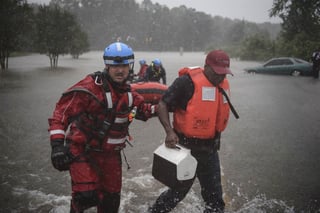 This year has been quite a year for natural disasters. Wildfires in California and the Pacific Northwest have destroyed homes, businesses, and wildlife as well as having negatively impacted air quality. Hurricanes have caused extensive flooding and major property damage in Texas, Florida, and Puerto Rico. Plus, multiple earthquakes in Mexico. These disasters effect everything; gas prices, crops, infrastructure, and also EMS health and safety.
This year has been quite a year for natural disasters. Wildfires in California and the Pacific Northwest have destroyed homes, businesses, and wildlife as well as having negatively impacted air quality. Hurricanes have caused extensive flooding and major property damage in Texas, Florida, and Puerto Rico. Plus, multiple earthquakes in Mexico. These disasters effect everything; gas prices, crops, infrastructure, and also EMS health and safety.
One thing that is common to fire, flood, wind, and earthquake disasters is the brave efforts of the first responders as they treat and transport patients under these difficult conditions. In order to emphasize EMS health and safety during this time, it is important to give them the right tools to do the job safely and effectively. One essential tool is a portable stretcher for transporting patients. In natural disasters, a flexible, foldable patient transport unit is essential. Emergency preparedness and patient transport go hand-in-hand.
Water
Record rainfall, combined with a massive storm surge, created devastating floods in Houston, Texas. Over 30,000 people were forced to evacuate into emergency shelters. Many of those evacuees required assistance whether at home or en route, leading brave responders like Police Sergeant Steve Perez to brave dangerous flood waters, ultimately leading to his death from rising waters. In situations that are so dangerous for EMS health and safety, the ability to move quickly without carrying heavy equipment is vital. The extra weight and bulky equipment of rigid gurneys and stretchers can be a detriment in heavy flood waters.
Debris
In 2016, Hurricane Matthew generated $1.2 million in emergency clean up costs, and the costs for Hurricane Irma are projected to go beyond that level. First responders still have to assist whether a location is clear or blocked by fallen trees or building materials, and the wheels of standard gurneys just can't maneuver through the debris. Under these conditions, patients need to be hand carried in order to safely navigate the terrain.
Limited Resources
In a natural disaster, resources are limited. Even where full medical equipment is accessible, the number of patient beds, room in ambulances, and even total count of emergency medical vehicles struggle to meet the demand. Compact emergency medical equipment that can fit in a pack enables EMS responders to reach more people and streamline the triage process.
The MegaMover® patient transport unit by Graham Medical provides safe patient transport during disasters. Focusing on EMS health and safety, the ergonomic design offers multiple handles capable of lifting up to 1,000 lbs. Click here or call us at (800) 558-6765 to learn more about the MegaMover® or to see if you qualify for a free sample.

